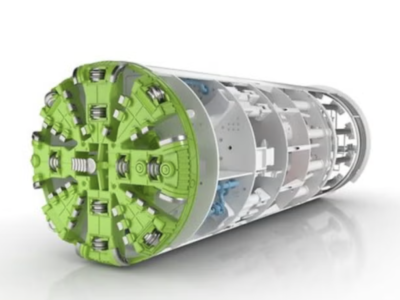In order to advancing link sewer tunnels for Auckland’s Central Interceptor project, Ghella Abergeldie JV has completed micro-tunneling using micro-TBM Domenica, which is a 2.8m diameter machine and on 24 Apri broke through into the almost 30m-deep Norgrove Avenue shaft following completion of the last 300m of Link Sewer B in New Zealand’s largest city.
Stretching from Mt Albert War Memorial Park to Rawalpindi Reserve, Link Sewer B is 1100m long, while the date of completing the excavation process on the 3.2km Link Sewer C was March last year.
Following collection of the combined wastewater and stormwater flows from West Auckland, the link sewers will send them to Mangere Wastewater Treatment Plant for processing, instead of discharging into streams and beaches during heavy rain.
Central Interceptor chief program delivery officer Shayne Cunis paid tribute to Ghella Abergeldie JV’s crew and stated: “The micro-tunneling teams, together with our own Watercare engineers, have consistently performed above expectations. They have completed more than 4km of tunneling safely and expertly, including a particularly long challenging single drive, with a lefthand bend.”
According to Ghella Abergeldie JV project director Francesco Saibene: “The multi-national crews completed the work despite constraints during the Covid pandemic and extreme weather. I am very proud of our crews, some of whom didn’t see their families for two years when borders were closed. Tunneling is an unusual job and you have to really pull together to work effectively. That’s what our people have done, since Domenica was first launched back in June 2021.”
While there are three TBMs that are working on the Central Interceptor project, linking the main tunnel to the local wastewater network in Mt Roskill is up to Victoria, a 12m-long micro-tunneling TBM; and nearly 200m-long TBM Hiwa-i-te-Rangi is currently 70m deep underground as she travels beneath Sandringham on her way to Pt Erin, Herne Bay as she builds the 16.2km-long main tunnel, whereas Domenica as the third one is due to be removed from the shaft in the coming days, along with pipe-jacking equipment and other services.
Teams of welders will carry out thermal welding on joins in the tunnel’s plastic liner, which protects against the corrosive effects of wastewater, helping to ensure a 100-year lifespan.
As the largest wastewater infrastructure undertaken in New Zealand history, the Central Interceptor project is going to store 226,000m3 of wastewater, control the flows into treatment plants and decrease the number of wastewater overflows into Auckland’s waterways and the Waitemata Harbour.
The determined date for inauguration of a section of the Central Interceptor tunnel, plus link sewers, is before the end of the year, while the project is slated to be completed in 2026.
















